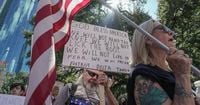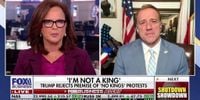On October 18, 2025, a wave of protest swept across the United States and beyond, as millions gathered for the largest coordinated demonstration in recent American memory: the “No Kings” rallies. From the sprawling Metroplex of Texas to the rain-soaked streets of Shreveport, Louisiana, and even as far as London, Berlin, and Rome, the message was loud and clear—Americans and their allies abroad were standing together to defend democracy and push back against what they saw as growing authoritarianism in the country’s highest office.
According to organizers and local police estimates, more than 20,000 people turned out across the Dallas-Fort Worth Metroplex alone. Dallas saw between 8,000 and 9,000 protesters (though police estimated about 3,000), while Fort Worth hosted 6,500, Arlington 1,400, Plano 1,300, Frisco up to 2,000, and Garland 400. Nationwide, the numbers were staggering: organizers claimed over 7 million participants at more than 2,600 protests, with events also held outside U.S. embassies in major European capitals. The scale was unprecedented, and the mood, by most on-the-scene accounts, was determined but peaceful.
“The movement is really about defending the Constitution and ending the authoritarian takeover,” explained Kimberly Ross, an organizer for the Shreveport, Louisiana, protest, speaking to the Shreveport Times. In Shreveport, close to 1,000 protesters braved the rain, gathering in unity on Texas Street. Their chants—“Stand up and fight back. Stand up and fight back”—echoed off courthouse steps, as passersby honked in support. The protest, like many others across the country, was marked by a sense of solidarity and patriotism, not the chaos some political opponents had predicted.
Despite the massive turnout and the largely peaceful nature of the events, the lead-up to the “No Kings” protests was fraught with tension. President Trump and prominent Republicans repeatedly characterized the planned demonstrations as extremist, criminal, and even terrorist in nature. Texas Governor Greg Abbott, for example, announced the deployment of state troopers and National Guard members to Austin, warning, “Texas will NOT tolerate chaos. Anyone destroying property or committing acts of violence will be swiftly arrested. Law and order will be enforced.” Abbott claimed, without evidence, that the rallies were linked to Antifa—an accusation echoed by other Republican officials, including Transport Secretary Sean Duffy and Senator Roger Marshall, who suggested the protests were funded by George Soros. Yet, as the New Republic reported, the reality on the ground was starkly different.
Writer Ana Marie Cox, who attended a rally in a deeply conservative Texas county, described seeing “mostly ordinary Americans who put on a civil and powerfully patriotic display.” According to her and many others, the protests were a repudiation of the MAGA movement and Trumpism—especially significant in areas that had overwhelmingly supported Trump in past elections. The absence of violence or significant disturbances was notable, with most scattered problems reportedly involving right-wing agitators attempting to provoke unrest.
President Trump’s own response to the events was, in a word, provocative. On the evening of October 18, he posted an AI-generated meme depicting himself wearing a crown in the cockpit of a fighter jet, spraying brown liquid—presumably excrement—onto the protesters below. The image, widely shared and discussed, was seen by many as a new low in presidential rhetoric. The next day, speaking to reporters aboard Air Force One, Trump dismissed the protests as a “joke,” declaring, “I looked at the people. They’re not representative of this country.” He further suggested, “I guess it was paid for by Soros and other radical-left lunatics. It looks like it was.”
This reaction, according to The Hill, was a stark example of how online trolling and political theater have come to define Trump’s second term. The president’s critics, including Senator Bernie Sanders, seized on the moment. Addressing the No Kings crowd in Washington, Sanders declared, “This is the kind of contempt that Trump and his fellow oligarchs have for ordinary Americans.” On social media, Sanders added, “7 million people came out for the largest demonstration day in our history. Americans are clear. They don’t want authoritarianism, oligarchy or a doubling in their insurance premiums.”
Republican leaders, meanwhile, struggled to find a unified response. House Speaker Mike Johnson, speaking to Real America’s Voice, labeled the protests “Hate America” rallies, predicting, “We’re going to have all the Marxists collected, all the antifa people, you know, the [Black Lives Matter] remnants, the pro-Hamas wing of the Democrat Party. They’re going to be out here demonstrating, and screaming and wailing.” Senator Ted Cruz alternated between accusing Democrats of promoting hate and mocking the age of some protesters, quipping, “boomers gotta boom…” in response to a post highlighting older participants at a Texas rally. Fox News and Fox Business aired segments downplaying the protests, with one chyron reading, “No kings but many boomers at weekend protests.”
Yet, for all the partisan noise, the reality remained: the “No Kings” protests were, by every credible account, peaceful, diverse, and vast in scale. From the largest cities to small towns deep in Republican territory, Americans turned out in force to express their opposition to what they saw as a drift toward authoritarianism. The organizers, for their part, saw the day as a resounding success. “Instead of reopening the government, preserving affordable healthcare, or lowering costs for working families, [Speaker Johnson is] attacking millions of Americans who are peacefully coming together to say that America belongs to its people, not to kings,” they said in a statement.
Local officials, too, sought to strike a balance between public safety and the right to protest. Austin Mayor Kirk Watson emphasized, “The city of Austin and I will continue to protect the right of people to peacefully assemble. I support people exercising their right to engage in peaceful protest against politics and policies that they disagree with. Power should always stay with the people, where it belongs.” Michael Bullock, President of the Austin Police Association, echoed that sentiment, warning against illegal activity but affirming the department’s commitment to facilitating peaceful demonstrations.
For many participants, the day was about more than politics—it was about the enduring promise of American democracy. As protester Allison Goins in Shreveport put it, “I love America. I’m not Marxist, I’m not socialist, I’m not pro Hamas. I go to church, I love my neighbor, and I believe in the First Amendment. I actually like all the Amendments. And I like checks and balances that help us keep it all in check.”
Whether the “No Kings” movement will translate into lasting political change remains to be seen. But for one day, at least, millions of Americans—and their supporters around the world—stood together to say that no one, not even a president, is above the people or the Constitution.

